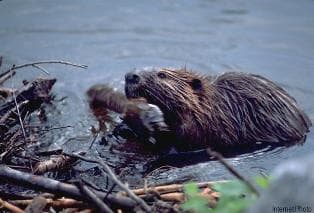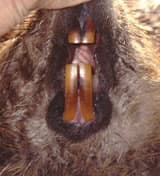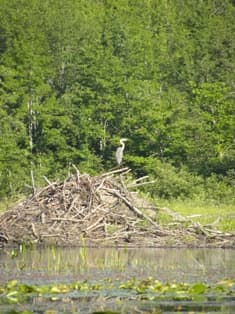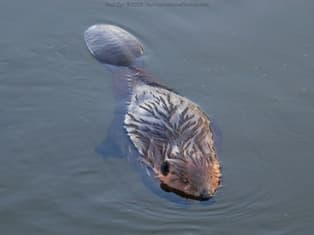Home → Fish & Wildlife → Wildlife → Living with Wildlife → How to Avoid or Resolve a Wildlife Conflict → Beavers
Beavers
On this page:
- Facts About Maine's Beavers
- Viewing Beavers
- Preventing Conflicts
- Public Health Concerns
- Legal Status
- Additional Information
Overview

Figure 1
Beavers (Castor canadensis) (Fig. 1) are the largest living rodents in North America, with adults averaging 40 pounds in weight and measuring more than three feet in length, including the tail. These semi-aquatic mammals have webbed hind feet, large incisors, and a broad, flat tail. This is the only species that can actually create its own habitat, and it does so by impounding water. In doing so, beavers provide quality wetland habitat for many dozens of species of birds, mammals, amphibians, invertebrates, and fish including ones that are rare, threatened, or endangered, across streams or other watercourses.
Once among the most widely distributed mammals in North America, beavers were eliminated from much of their range in the late 1800s because of unregulated trapping. With a decline in the demand for beaver pelts and with proper management, they became reestablished in much of their former range and are now common to abundant in many areas.
Beavers are found where their preferred foods are in good supply – along rivers and streams, in ponds and lakes, and even in roadside ditches containing adequate year-round water flow. In areas where deep, calm water is not available, beavers that have enough material will create impoundments by building dams across streams or other watercourses.

Figure 2: Photo Credit - Russell Link
Beaver dams create habitat for many other animals and plants. Moose use the highly nutritious emergent and submergent aquatic plants found in the deeper beaver flowages. In winter, deer and moose may frequent beaver ponds to forage on shrubby plants that grow where beavers cut down trees for food, dams, or lodges. Deer benefit from lush meadows that develop along flowages when beaver dams no longer hold water. Otters, mink, raccoons, and herons hunt frogs and other prey along the marshy edges of beaver ponds. Waterfowl such as black ducks, wood ducks, hooded mergansers, and green-winged teal are closely tied to these flowages to forage, raise young, and rest during migration. Ducks and geese may even nest on top of beaver lodges, which offer warmth (from the beavers that live below) and protection (especially when lodges are located in the middle of a pond). Trees killed by rising water levels provide perch sites for avian predators, habitat for insects, and food for insect-eating birds such as woodpeckers. These trees also develop cavities that many species of animals require for nesting.
The beaver's incisors (front teeth) are harder on the front surface than on the back, and so the back wears faster. This pattern creates a sharp edge that enables a beaver to easily cut through wood (Fig. 2).
Like many rodents, beavers construct nesting dens for shelter and for protection against predators. These may be burrows in a riverbank or the more familiar lodges built in the water (Fig. 3) or on the shore (shown here). However, the basic interior design varies little and consists of one or more underwater entrances, a feeding area, a dry nest den, and a source of fresh air.

Figure 3: Photo Credit - Ashley Malinowski
Facts about Maine's Beavers
Food and Feeding Behavior
- Leaves, inner bark, and twigs of deciduous trees and shrubs make up the primary food. "Popple" (aspen) is the favorite followed by birch, cottonwood, willow, oak, and maple. Beavers will also eat herbaceous plants, grasses, and some aquatic plants. Beavers rarely eat coniferous trees such as fir, spruce, and pine. More often, beavers will use these trees as dam-building material or girdle and kill them to encourage the growth of preferred food plants.
- Beavers have large, sharp incisors that grow continually. The animal wears them down by cutting trees, peeling bark, and feeding (Fig. 2).
- Fermentation by intestinal microorganisms allows beavers to digest thirty percent of the cellulose they ingest.
- Beavers store food for the winter months by stashing stems underwater, anchoring them to the bottom of the lake or stream. When ice makes it impossible to forage on land, they feed on the bark and stems in their cache and on the thick roots and stems of aquatic plants, such as pond lilies and cattails. Surviving such harsh conditions also requires heavy fur, a well-insulated den, and fat reserves.
- Beavers do not hibernate, but are less active during winter, spending most of their time in the lodge or den.
Beaver Dams
- Dams increase the water depth, allowing beavers to store food where it will not be frozen into ice in the winter. Flooding also lets beavers construct underwater entrances to their lodge, which in turn protects them from predators. The higher water level promotes the growth of favored aquatic food plants. The limiting factor in dam height is that the dam and water elevation cannot be higher than the living quarters, or the den will be flooded. Dam maintenance is critical, and beavers keep them in good repair.
- Beavers living in lakes and rivers with a constant water level do not build dams and may not build a typical lodge.
- Beavers construct and maintain dams with whatever materials are available – wood, stones, mud, and plant parts. Dams are typically three to four feet high but may be higher. Most dams are less than 50 feet long length but they can be much longer depending on the physical aspects of the basin in which the impoundment lies.
- The feel and sound of flowing water stimulate beavers to build dams. However, they routinely let a leak in a dam flow freely, especially during times of high water.
- Beavers may enlarge their dam to increase the impoundment and allow access to more food. They are limited by the physical characteristics of that basin and the elevation of the den floor within their lodge. A family may build and maintain one or several dams in its territory.
Lodges and Bank Dens
- Lodges and bank dens are used for safety and as a place to rest, stay warm, give birth, and raise young.
- Lodges consist of a mound of branches and logs plastered with mud. One or more underwater openings lead to tunnels that meet at the center of the mound, where there is a single chamber. Beavers build freestanding lodges in areas where the bank or water levels aren't sufficient for a safe bank den.
- Beavers can also dig into the banks of streams and large ponds, leading to the term "bank beavers." They may or may not build a lodge on top. Bank dens may also be located under stumps, logs, or docks.
- One family can have several lodges or bank dens, but will typically use only one area during winter.
Reproduction and Family Structure
- A mated pair of beaver can live together for many years, sometimes for life.
- Beavers breed between January and March; females produce a litter of one to eight kits (average four) between May and June. The number of kits is related to the amount of food available – more food, more kits – and the female's age.
- The female nurses the kits until they are weaned at 10 to 12 weeks of age.
- Most kits remain with the adults until they are almost two years old; some leave at 11 months and a few females may stay until they are three years of age.
- Beaver are sexually mature at age two. At or just before this age they leave on their own or are driven off to find a mate and establish their own colony. Beavers causing new problems in sub-optimum habitat are often these newly dispersing individuals.
- Beavers live in colonies that may contain two to twelve individuals. The colony is usually made up of the adult breeding pair, the kits of the year, and kits of the previous year.
- Populations are limited by habitat availability. Under the best of conditions, colonies will be at least half a mile apart.
Mortality and Longevity
- Though an aquatic lifestyle and protected dens are effective survival strategies, black bears, coyote, lynx, bobcat, fisher, and dogs prey upon beavers that are foraging on shore or migrating overland.
- Other identified causes of death are severe winter weather, winter starvation, disease, water fluctuations, floods, and falling trees.
- Humans are a significant cause of mortality mainly through regulated recreational trapping. Historically, beavers have been one of the most commonly trapped furbearers. The yearly average in Maine is about ten thousand animals a year.
- Beavers can live 20 years in captivity but far fewer than that – perhaps five to 10 years – in the wild.
Viewing Beavers
Probably no animal leaves more obvious signs of its presence than the beaver. Prominent, well maintained dams and lodges and freshly cut trees and shrubs are sure indicators. "White wood" is also a clue indicating recent activity. Debarked wood will turn gray due to oxidation over weeks, months, and years. Freshly cut wood around lodges and dams, however, will be nearly white in color. The presence of beaver can be confirmed by creating a minor leak in a dam and returning the next day to see if it was repaired.
Because debarked wood turns gray, "white wood" indicates recent beaver activity.

Figure 4: Photo Credit - Paul Cyr
Although beavers (Fig. 4) are often active during the day, they are primarily nocturnal, so the best time to see them is very early (before sunrise) or very late (after sunset). Approach a flowage slowly and from the downwind side, as beavers have poor eyesight but excellent hearing and sense of smell. Look for a V-shaped series of ripples on the surface of calm water. A closer view with binoculars may reveal the nostrils, eyes, and ears as the animal swims.
If you startle a beaver, it will most likely slap its tail hard on the surface of the water and dive. Chances are that it will reemerge within one or two minutes, so if you wait quietly in a secluded spot, you may see it again. Beavers can slow their heart rate, so they are able to remain underwater for at least 15 minutes.
Observers often mistake a beaver in the water for a muskrat. Try to get a look at the tail. Beavers have a broad, flat tail that does not show when they are swimming. Muskrats have a narrow tail that it holds out of the water or sways back and forth on the surface of the water as it swims.
Beavers may stand their ground and should not be closely approached or cornered on land. They face the aggressor (real or perceived), rear up on their hind legs, and hiss or growl loudly before lunging forward to deliver extremely damaging bites.
Harvest Sites
Beavers cut down trees, shrubs, and other available vegetation for food and building materials. Tooth marks look like twin grooves, each groove measuring one-eighth inch or more. They generally eat all of branches and twigs under three-quarters of an inch in diameter. The cut on small wood is usually at 45 degrees (typical of the Rodent Order, of which the beaver is a member). If a limb is too large to be hauled off, the beaver typically strips off the bark over the course of several days. Large stumps are pointed, one to two and a half feet high (sometimes the tree trunk is still attached) with a pile of wood chips around the base.
Most harvesting is done within a hundred feet of the water's edge. In areas with a lean food supply and few predators, beavers may range farther up to three hundred feet from the den site, leaving toppled trees and other signs of feeding in their wake. Beavers can transport woody material even farther by water.
By late fall, all family members concentrate on repairing and building up dams and the family lodge in preparation for winter. Wood harvesting is at its most intense level at this time of year.
Slides
Beavers make slides when they enter and leave the water. These paths are 15 to 20 inches wide, at right angles to the shoreline, and have a slicked down or muddy appearance. Otter slides, in contrast, are usually six or seven inches wide.
Channels
When the water level recedes during summer, beaver activity shifts toward building and maintaining channels to access new food supplies. These canal systems allow animals to float food such as small, trimmed trees from harvest sites to their pond. Channels often look constructed rather than natural; they have soft, muddy bottoms, and are filled with 15 to 25 inches of water. The other advantage of canals is that beavers are safer when they are swimming than when they are walking; in the water, they are less vulnerable to predators.
Food Storage Sites
Beavers that live in cold climates store branches of food trees and shrubs for winter by shoving them into the mud at the bottom of ponds or streams near the entrance to their bank den or lodge.
Droppings
Beavers seldom defecate on land; when they do, their scat is likely to be found at the water's edge. Droppings are usually cylindrical, up to two and a half inches long and on average one inch in diameter. Beaver pellets look like they have been formed of compressed sawdust. Fresh deposits are dark brown with lighter bits of undigested wood; everything turns pale with age.
Sounds
In order to warn each other of danger, beavers slap their tails against the water, creating a loud splash. Adults will issue a breathy greeting noise, blow loudly when upset, and – rarely – can be heard humming while they swim. Kits will whine.
A Beaver's Tail
A beaver's tail is covered with leathery scales and sparse, coarse hairs. A large beaver's tail may be 15 inches long and six inches wide.
The tail is important both in the water and on land. It serves as an area for storing fat, and because it is nearly hairless, it releases body heat, helping the beaver to regulate its body temperature.
In the water, the animal uses its flexible tail as a four-way rudder. When diving after being frightened, a beaver loudly slaps the water with its tail; the sound warns all beavers in the vicinity that danger is near, and perhaps serves to frighten potential predators. On land, the tail acts as a prop when a beaver is sitting or standing upright. It also serves as a counterbalance and support when a beaver is walking on its hind legs while carrying building materials with its teeth, front legs, and paws. Contrary to common belief, beavers do not use their tails to plaster mud on their dams.
Resolving and Preventing Conflicts
Despite an appreciation for these animals and our best intentions to live with them, beavers can become a problem if their eating habits or dam/den building activity flood or damage property. Before beginning any control action, assess the problem fairly and objectively. Are beaver really causing damage or creating hardship requiring control action? The very presence of beavers is often seen as a problem when, in fact, the beavers are causing no harm.
You need to determine the type of damage the animals are causing and then match it with the most appropriate and cost-effective control method. There are three control options: prevention, beaver translocation, and lethal removal.
Prevention
Commonly referred to as site modification, this action involves constructing physical barriers to deny the beavers access to individual trees or culverts, or piping to manage water levels. Fencing and piping structures vary greatly in design and cost. They can be very simple projects that a property owner can complete, or they may be more complicated and require commercial (and more expensive) assistance.
Prevention is usually the most cost-effective action because it addresses current beavers as well as any future dispersing beavers looking for unoccupied habitat. Preventive measures can be long-term or permanent. Prevention has the side benefit of conserving wildlife.
Prevention is the first choice when dealing with blocked culverts, loss of ornamental or shade trees, and impounded water that floods standing timber.
How to prevent conflicts or remedy existing problems (PDF)
Live Trapping and Moving Beavers
Live trapping and moving beavers elsewhere (relocating) can be effective when problems occur in low-quality habitat (note: only animal damage control agents, as authorized by regional biologists, can relocate beavers). It can be more costly than prevention if the relief is only temporary or if there are a lot of beaver to remove; it is often cost-prohibitive. The obvious benefit of translocation is that it conserves wildlife. In urban areas, however, where lethal trapping may be illegal or unsafe, live trapping may be the only alternative.
Research has shown that beavers seldom survive relocation, and those that do often move great distances from the release site. Younger beaver in particular may not survive if they are separated from their family group, removed too late in the season, or relocated to an unsuitable (or occupied) area.
To help ensure the survival of beavers, the gradient of the watercourse at the release site should be less than three percent and the site should have adequate food supply. The move should occur before or during their principal dam-building period, July to September. This schedule will allow them time to gather a food cache, but limit their time to explore before preparing for winter. Providing beavers with a pickup-truck load of poplar or other tree species to use as building material at or near the release site may encourage it to stay nearby. See "Trapping Wildlife" for additional information on trapping and moving beavers.
If you are moving beavers to a different site, particularly a site where other beavers are not already present, there must be cooperation between adjacent landowners and local wildlife officials. A cooperative evaluation of existing habitat quality and potential adverse beaver activity is also very important. A landowner should expect a beaver to cut and use a large number of trees for dam construction during the first year or two.
Live-trapping of beavers may only be done by certified Animal Damage Control agents and with the approval of the Regional Wildlife Biologist.
Hancock or Bailey suitcase-type traps are the most commonly used live trap. (Due to the weight and dangers associated with suitcase traps, it is recommended that only people experienced with these traps use them.) Some success has also come from using a four-foot long cage trap set right at the water's edge next to the beaver slide. Bait for live traps include freshly cut tree sprouts or branches of preferred foods, apples, and commercial scents and lures.
Lethal Control
Lethal control may become necessary when all efforts to dissuade problem beavers fail. Removing beavers is rarely a lasting solution as survivors have larger litters, and others will resettle good habitats. As with live relocation, lethal removal is most effective where beaver problems are not chronic and occur in low-quality habitat.
Lethal trapping has traditionally been the primary form of controlling beaver damage. If you feel you need to have a beaver trapped, you can ask a recreational trapper to resolve problems during the open trapping season, which runs from late fall through winter to early spring. Outside of the recreational trapping season you can hire an animal damage control agent to remove nuisance beaver.
For chronic problem sites or areas with high-quality habitat, annual recreational trapping should still be part of a long-term strategy because it is free of cost and provides opportunity for local licensed beaver trappers. Unless it is an emergency, delay lethal removal until the open trapping season. District game wardens and regional wildlife biologists can assist with trapper contacts in your area.
Call your local Fish and Wildlife regional office for contact information. See "Legal Status" and "Hiring an Animal Damage Control Agent" for additional information.
Note: Regional wildlife offices do not provide animal removal services; however, they maintain lists of animal damage control agents by city or town.
It is illegal to kill a beaver out of season without approval by MDIFW.
Public Health Concerns
Tularaemia
Beavers can be infected with the bacterial disease tularemia, which is transmitted by ticks and biting flies as well as contaminated water. Animals with this disease may be sluggish, appear tame, or be unable to move quickly when disturbed. Tularemia is fatal to animals.
Tularemia may be transmitted to humans who drink contaminated water; eat undercooked, infected meat; are bitten by an infected tick or biting fly; inhale dust from contaminated soil; or allow an open cut to contact an infected animal. The most common route of infection occurs when someone who is skinning or gutting an infected animal is cut or nicked by a knife.
A human who contracts tularemia commonly has a high temperature, headache, body ache, nausea, and sweats. A mild case may be confused with the flu and ignored. Humans can be easily treated with antibiotics.
Giardia
Because beavers defecate in water, they can be one of several vectors (transmitters) of a flu-like infection called giardiasis, more commonly referred to as giardia (derived from giardia, the single-cell protozoan that causes the disease).
Giardia has been found in many animal species, including pets, other wildlife, and livestock. It is one of the most common water-born pathogens in fresh water. Its main source is fecal material from birds and animals as well as humans. Never drink untreated water from any source in the wild.
Legal Status
Because the legal status of and trapping restrictions for this species can change, contact your local regional wildlife office for updates.
If beavers are causing damage or are a nuisance, consult Maine's laws on this subject: See the entire section and specifically see Subsection 2: Beavers. (http://www.mainelegislature.org/legis/statutes/12/title12sec12404.html)
Additional Information
Books
New England Wildlife, Habitat, Natural History, and Distribution
Written by: Richard DeGraff, and Mariko Yamasaki
University Press of New England, 2001.
(Available from: www.upne.com)
Wild Mammals of New England
Written by: Alfred J. Godin
The John Hopkins University Press. 1977
Land Mammals of Oregon
Written by: B.J. Verts, and Leslie N. Carraway
Los Angeles: University of California Press, 1998.
Prevention and Control of Wildlife Damage
Written by: Scott E. Hygnstrom, et al
Lincoln, NE: University of Nebraska-Lincoln, Institute of Agriculture and Natural Resources, 1994.
Available from:
University of Nebraska Cooperative Extension
202 Natural Resources Hall
Lincoln, NE 68583-0819
phone: 402-472-2188; also see Internet Sites below.
The Beaver: Natural History of a Wetland Engineer
Written by: Muller-Schwarze, D., and Lixing Sun
Ithaca, NY: Cornell University Press; and London: Comstock Publishing, 2003.